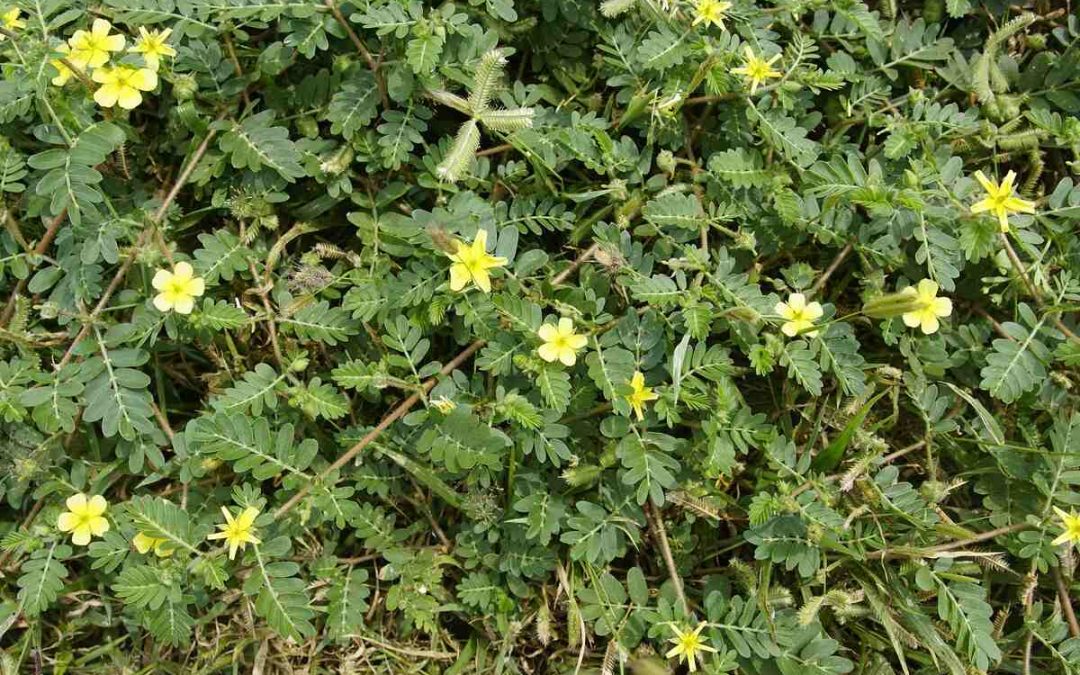It may not seem like much can grow in the heat of the desert, but even New Mexico’s intense droughts and arid climate can’t stop weeds from popping up on your lawn. It’s hard enough for your turfgrass to survive the state’s scorching heat without weeds stealing essential nutrients and crowding it out.
You don’t want to be stuck out in the heat trying to eliminate weeds using ineffective methods. Discover seven of the worst New Mexico weeds and how you can effectively get rid of them.
In this article, we’ll cover:
- Camelthorn (Alhagi maurorum)
- Leafy Spurge (Euphorbia esula)
- Pigweed (Amaranthus spp.)
- Puncture Vine (Tribulus terrestris)
- Purslane (Portulaca oleracea)
- Russian Thistle (Salsola tragus)
- Silverleaf Nightshade (Solanum elaeagnifolium)
Why Are Weeds Bad for Your New Mexico Lawn?
It can be a big problem when invasive weeds sneak into your yard uninvited. And the sooner you detect and identify the invasive plants in your lawn, the easier it is to remove them.
Here are some of the reasons weeds are bad for your New Mexico lawn:
- Weeds steal sunlight, water, and essential nutrients from your grass.
- They spread pests and diseases.
- When left untreated, the weed infestation will be harder to remove.
- Weeds tend to invade sickly or patchy turfgrass. So the appearance of weeds in your lawn is usually a sign of your lawn’s poor health, indicating underlying issues like overwatering.
- They disrupt the uniform look of your grass lawn.
As such, it is recommended to weed your yard once every 1-2 weeks.
7 Worst New Mexico Weeds
1. Camelthorn (Alhagi maurorum)
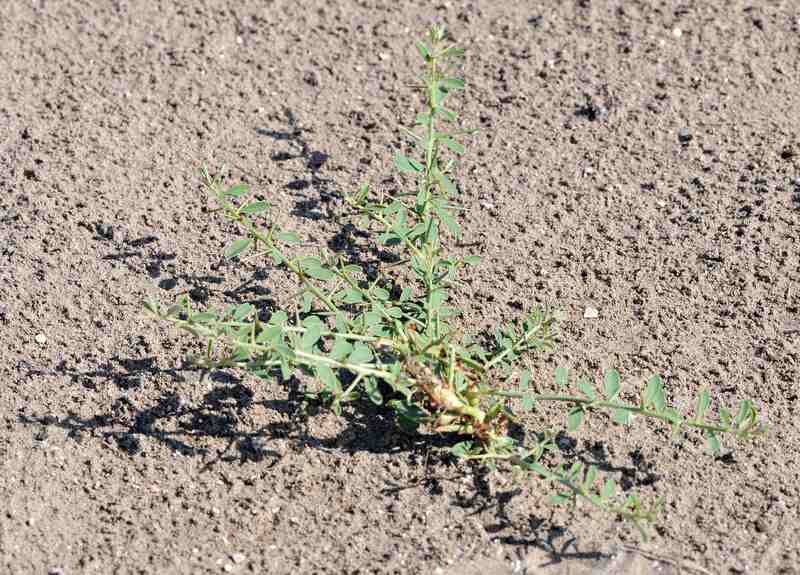
Photo Credit: Zeynel Cebeci / Wikimedia Commons / CC BY-SA 4.0
Native to arid regions of Eurasia and North Africa, camelthorn grows in a tangle of multiple stems around 2 to 4 feet tall. The tips of its stems are lanced with spiny yellow thorns. From June to August, camelthorn blossoms with pea-like flowers that are brown, maroon, or pink. It produces reddish-brown fruit that grows in seed pods.
One of the worst weeds in Arizona and New Mexico, camelthorn can be difficult to remove once it has been established due to its extensive root system. In fact, the state’s Department of Agriculture included it in their noxious weed list. This invasive shrub spreads through seeds or pieces of root left in the ground.
Plant type: Perennial shrub
USDA hardiness zone: 6-10
Habitat: This aggressive invader can thrive in dry, sandy, or gravelly habitats like steppes, roadsides, irrigation ditches, and disturbed areas.
Danger: Its sharp thorns can injure people and animals. Plus, camelthorn growing in pavement cracks can puncture car tires.
Removal method: Hand removal, herbicides
2. Leafy Spurge (Euphorbia esula)
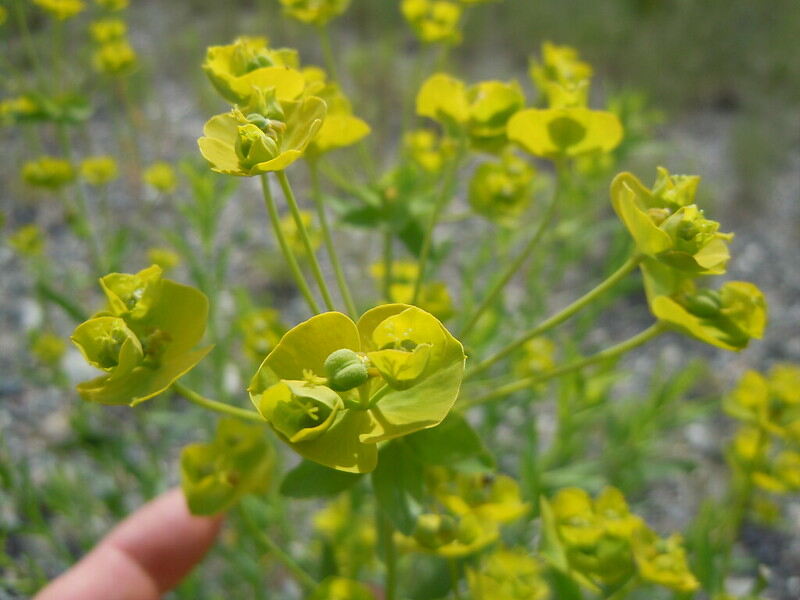
Photo Credit: Matt Lavin / Flickr / CC BY-SA 2.0
Another invasive species native to Eurasia, leafy spurge grows 2 to 4 feet tall in the Southwest. Its tall, smooth stem is surrounded by narrow, spiny leaves that have a bluish-green hue. A cluster of greenish-yellow flowers grows at the top of the stem.
With its extensive root system, leafy spurge thrives in full or partial sun. When the seed pods dry out, they explode and can shoot seeds up to 20 feet away from the parent plant.
Plant type: Perennial weed
USDA hardiness zone: 3-9
Habitat: Leafy spurge isn’t picky; it tolerates many soil types, though it prefers dry soil. Leafy spurge grows in disturbed areas, pastures, prairies, savannas, grasslands, prairies, fields, and roadsides.
Danger: This weed produces a milky sap that can blister or irritate the eyes and skin. It also displaces resident plants and reduces biodiversity.
Removal method: Hand removal for small infestations and herbicides for larger ones. Tilling the earth repeatedly until the spurge infestation is gone is also an effective way to get rid of this weed.
3. Pigweed (Amaranthus spp.)
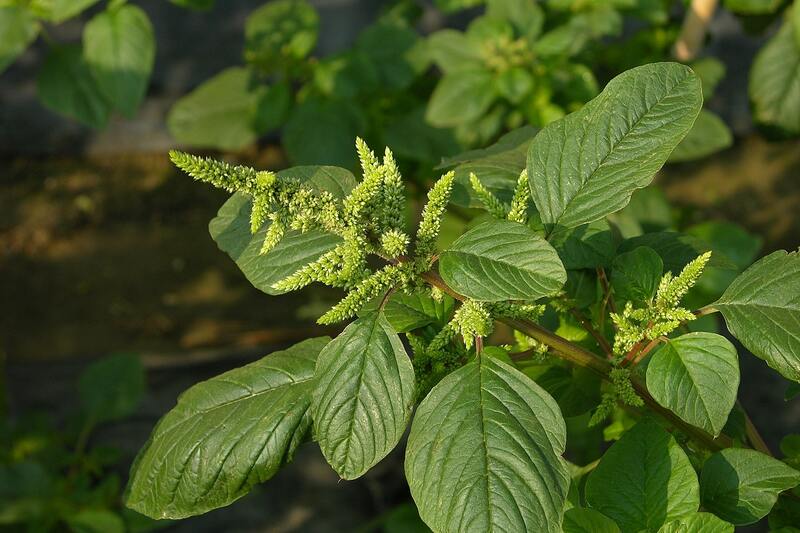
Photo Credit: Earl Benton / Wikimedia Commons / CC BY-SA 4.0
Pigweed has a tall, stout stem populated with large oval-shaped leaves that end in a crisp point – giving the leaves a near-diamond shape. Its erect stem is covered in fine hairs. Every part of the plant is green, even its flowers, which blossom in vertical clusters during summer.
Also called amaranth, pigweed sets down a deep taproot. This aggressive broadleaf weed can grow to be quite a large plant, sometimes reaching up to 7 feet tall. A heat-loving plant, pigweed can withstand New Mexico’s high temperatures.
All parts of this annual weed are edible and high in nutrition. In some areas, pigweed is cultivated for its culinary properties rather than treated as a weed. There are multiple species of pigweed, including redroot pigweed and prostrate pigweed.
Plant type: Broadleaf annual weed
USDA hardiness zone: 6-12
Habitat: Prefers growing in disturbed soil. It can be found in cultivated fields, along roadsides, streams, rivers, and agricultural cropland.
Danger: None – this weed is edible
Removal method: Hand removal, pre-emergent and post-emergent broadleaf herbicides
4. Puncture Vine (Tribulus terrestris)
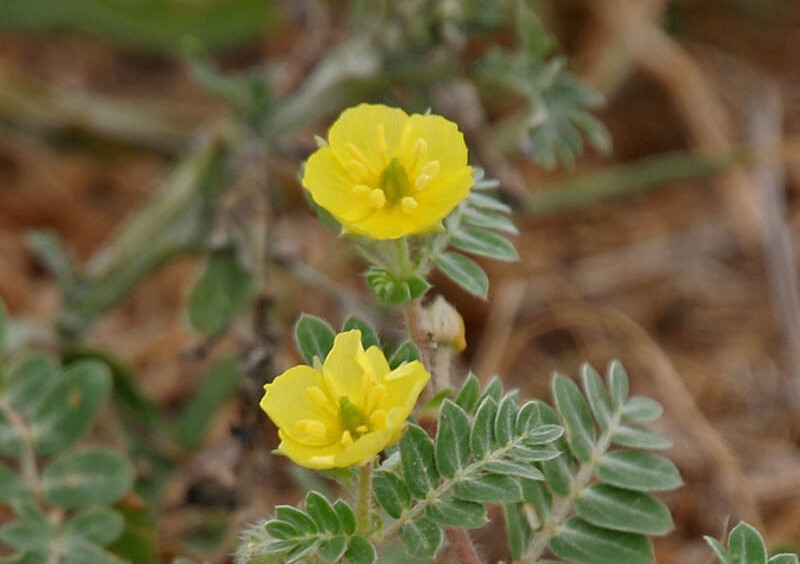
Photo Credit: J. M. Garg / Wikimedia Commons / CC BY-SA 4.0
As sharp as it sounds, puncture vine produces spiky seed pods – the source of its infamously painful thorns. Also called goathead, this summer annual grows miniature dark green leaves that are fern-like in appearance. Its thick, hairy stems can be green, red, or brown. It blooms with yellow flowers that have five petals.
Native to the Mediterranean region, this fast-growing weed has a taproot that helps it survive in arid climates, but it grows the fastest in places where water is available. With its germination occurring in spring and summer, this low-growing plant creeps horizontally along the earth and can spread out up to 3 feet.
Plant type: Annual broadleaf weed
USDA hardiness zone: 4-10
Habitat: It grows in varying conditions but prefers hot, dry climates with full sun. Its natural habitat includes orchards, pastures, fields, ditches, and roadsides.
Danger: Puncture vine is toxic to livestock if ingested. Stepping on its sharp spikes is very painful and can injure people or animals. They can puncture bike tires and are near impossible to pull out of flip-flops.
Removal method: Hand removal, herbicides
5. Purslane (Portulaca oleracea)

Photo Credit: Bob Peterson / Flickr / CC BY 2.0
Sometimes regarded as a weed and sometimes as a delectable food, purslane is an often unwanted invader in New Mexico lawns. However, not all homeowners resent the plant since it has nutritional benefits and medicinal uses.
Its rounded spoon-shaped leaves cluster around a fleshy, reddish-brown stem. In the summer, purslane blooms with small yellow flowers. This low-growing plant reproduces through seed and grows horizontally, creeping along the ground like a ground cover. Also, it doesn’t need much water to grow.
Since purslane can grow from fragments of roots or leaves left in the ground, be sure to remove all parts of the plant if you don’t want it to invade your lawn.
Plant type: Annual succulent plant
USDA hardiness zone: 5-10
Habitat: Purslane grows in all 50 states and thrives in disturbed soil. It naturally thrives in orchards, crop fields, or roadsides but can pop up in gardens, flowerbeds, container gardens, or cultivated soils.
Danger: While purslane is nutritious and safe for people to eat, it is toxic for pets who consume the weed.
Removal method: Hand removal, herbicides
6. Russian Thistle (Salsola tragus)
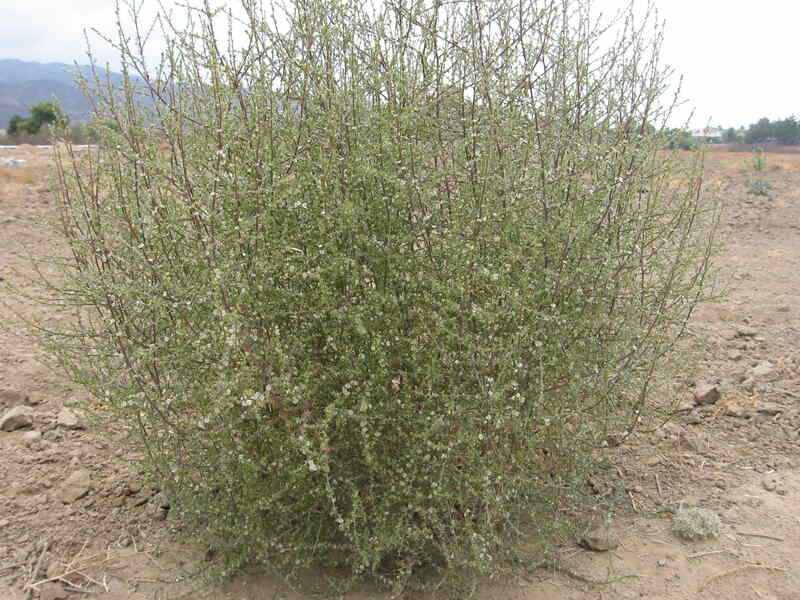
Photo Credit: miheco / Flickr / CC BY-SA 2.0
While the term “tumbleweed” is often used colloquially to describe any dried plant that tumbles in this manner, it is most commonly associated with the Russian thistle. This prickly, bushy weed dries up in the fall and becomes a wandering ball of stems that tumbles along in the wind, spreading seeds for miles as it goes.
A desert-friendly plant, Russian thistle doesn’t need much water to germinate, and its deep taproots allow it to soak up nutrients from the ground. Growing in a dense tangle of rigid stems, the yellow-green weed grows up to 3 feet tall. With narrow, thin leaves that grow in slender, vertical clusters, it blooms with pink, lavender, or white flowers.
Plant type: Annual broadleaf weed
USDA hardiness zone: 7-8
Habitat: Russian thistle grows in semi-desert areas and thrives in disturbed soils and agricultural areas. It prefers loose, sandy soils and can be found in roadsides, stream banks, waste places, pastures, fields, and croplands.
Danger: Tumbleweeds can cause problems – dry Russian thistles can be a fire hazard. In dense infestations, they can limit access to grazing lands for livestock and wildlife.
Removal method: Hand removal is best for young plants and seedlings. Herbicides are most effective when applied at the seedling stage. Large infestations are extremely difficult to remove. Preventative chemicals and maintaining a healthy lawn are the surest ways to prevent Russian thistle weeds from ever sprouting up in your yard.
7. Silverleaf Nightshade (Solanum elaeagnifolium)
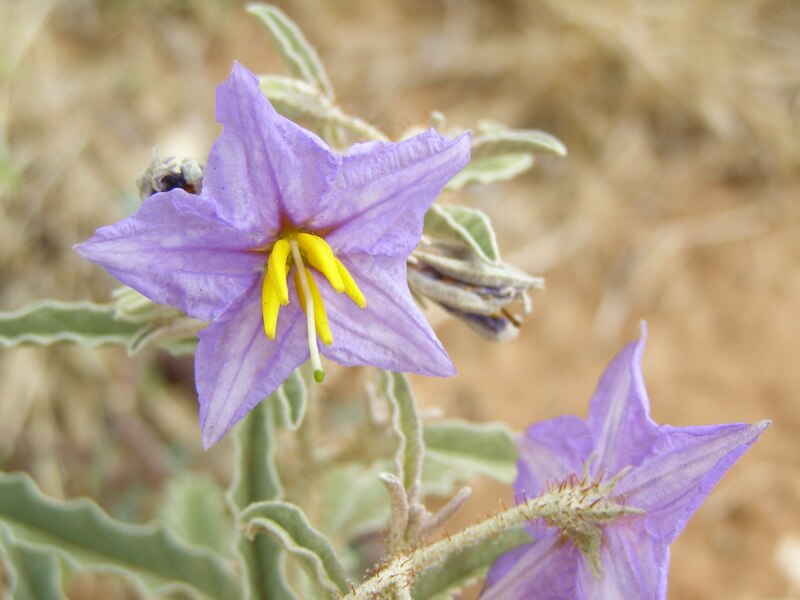
Photo Credit: pschemp / Wikimedia Commons / CC BY-SA 3.0
Don’t let the floral beauty of silverleaf nightshade fool you. All parts of the weed, including its leaves and fruit, are toxic. Native to New Mexico, this perennial weed has silvery green leaves and yellow or red thorns protruding from its stem – ready to prick any threat that endangers it.
Silverleaf nightshade has deep roots and can grow up to 3 feet tall. It produces purple and white star-shaped flowers with a prominent yellow stamen. Its flowers bloom from May through October and produce fruits that look like mini yellow tomatoes. Its long, thin leaves branch out to 2 to 4 inches long.
Plant type: Perennial weed
USDA hardiness zone: 7-11
Habitat: A sun-loving plant, silverleaf nightshade grows in arid climates. Often found thriving in agricultural areas and disturbed soils, its natural habitat includes prairies, open woods, croplands, roadsides, marshes, and stream banks.
Danger: Toxic to humans and animals. In extreme cases, it can be lethal if ingested.
Removal method: Hand removal or herbicides – it will grow back after being clipped or mowed, so be sure to remove the entire plant. Weekly mowing before the seed-growing season prevents the seed from spreading.
Getting Rid of Weeds By Hand vs. Pesticide
To eliminate weeds from your lawn, you can use chemical pesticides or pull them up by hand. The best weed removal method depends on the type of weed and the size of the infestation.
Hand Removal
Removing weeds by hand is the simplest and safest way to remove weeds from your yard. Since it reduces the need for chemicals, it is also the most eco-friendly way to get rid of weeds.
Hand pulling can be slow and time-consuming, especially if there are a lot of weeds. But for smaller weed infestations, pulling up a few by hand should be a piece of cake.
Here are some tips for hand pulling weeds:
- Tools such as a garden trowel, screwdriver, or hoe help pull up weeds. For removing weeds with taproots, a dandelion fork or screwdriver works best.
- Since weeding can be tedious, it may be tempting to procrastinate. But the longer a weed has to establish in your yard, the more difficult it is to remove.
- Pull up the entire weed, including tubers, bulbs, and roots. Leaving parts of the weed on the ground can make it grow back.
Herbicides and Chemical Treatments
For severe or widespread weed infestations, use chemical weed control treatments instead of manual hand weeding methods.
- Pre-emergent herbicides kill seeds before they have a chance to germinate.
- Post-emergent herbicides can kill visible weeds that have already grown.
- Iron-based herbicides are used only for broadleaf weeds.
You can either hire a pro to apply pesticides or treat your lawn yourself. For DIY jobs, read the herbicide instructions carefully and follow them so you don’t unintentionally end up damaging your lawn.
FAQs About the Worst New Mexico Weeds
Some of the weeds found in New Mexico gardens aren’t safe for children or pets. If the invasive weeds in your yard are poisonous, remove them ASAP. Apart from silverleaf nightshade, here are other poisonous weeds to look out for:
● Death camas (Zigadenus spp.)
● Desert marigold (Baileya multiradiata)
● Jimsonweed (Datura stramonium)
● Oleander (Nerium oleander)
● Poison hemlock (Conium maculatum)
● Redroot pigweed (Amaranthus retroflexus)
Noxious weeds are invasive plants that can harm native plants and wildlife and threaten to destroy the local ecosystem. New Mexico State University (NMSU) has a noxious weed list available for reference. Apart from camelthorn and leafy spurge, the other noxious weeds in the list include:
● African mustard (Brassica tournefortii)
● Bull thistle (Cirsium vulgare)
● Canada thistle (Cirsium arvense)
● Dalmatian toadflax (Linaria dalmatica)
● Dyer’s woad (Isatis tinctoria)
● Hoary cress (Lepidium draba)
● Myrtle spurge (Euphorbia myrsinites)
● Musk thistle (Carduus nutans)
● Russian knapweed (Rhaponticum repens)
● Spotted knapweed (Centaurea stoebe)
You can use vinegar for killing weeds, but it isn’t very effective since it only targets the top part of the weed, not the roots. It works as an eco-friendly solution for small patches of weeds, but it’s not effective against larger infestations.
When you’re buying herbicides to treat your lawn, determine whether the herbicide is selective or non-selective. Selective herbicides are usually best for homeowners, while non-selective herbicides are used by weed control professionals.
Selective herbicides target a specific type of weed or family of weeds.
Non-selective herbicides are broader in application use, as they target many kinds of weeds, not just one specific type. The trouble with non-selective herbicides is that they are so effective – if not applied carefully, they also might kill the turfgrass or other nearby lawn plants too.
To prevent summer weeds from growing, you should apply pre-emergent herbicides in early spring – specifically in March or April. Spray pre-emergent herbicides in September or October to prevent winter weeds from growing. Always read the herbicide’s label instructions before you start spraying.
Professional Weed Control for Your New Mexico Landscape
Pulling weeds in temperatures that regularly reach 90 to 100 degrees Fahrenheit isn’t anyone’s idea of a good time. That’s why you should keep your New Mexico lawn well-maintained and healthy in order to discourage weed growth.
If you’re looking for ways to reduce the amount of time and effort you have to put in your lawn, check out ideas for a low-maintenance landscape or help conserve natural resources with a drought-resistant landscape. Installing some native plants in your yard is another way to help improve your yard’s health and keep the weeds at bay.
Looking for a New Mexico lawn care pro near you? We have trusted lawn care pros in Albuquerque and many more cities across the Land of Enchantment.
Main Image Credit: Vengolis / Wikimedia Commons / CC BY-SA 4.0

